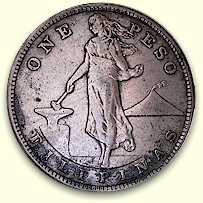Not
until he arrived did
he finally find out
what he was there
for. The mission was
to locate and
hopefully recover
270 tons of silver
pesos, valued at
$8,500,000, that had
been dumped into
Manila Bay off the
island of Corregidor
by orders of General
Jonathan Wainwright
in April 1942, when
the surrender of
U.S. forces to the
Japanese appeared
imminent. Gold,
securities and the
silver coinage had
been brought from
the Treasury in
Manila to Corregidor
before the city was
ceded to the
Japanese invading
forces in January;
the gold and
securities had
departed with
General Douglas
MacArthur to
Australia on the
famous PT boat, but
the silver was too
heavy to move, so it
had been carefully
boxed up and dumped
into 130 feet of
water in an area
between Corregidor
and the mainland.
The site was
carefully surveyed
at the time, but in
the terrific
destruction caused
by the bombing and
shelling of
Corregidor, all the
landmarks had been
blown up. In an
interview he gave on
the “Engineer Show,”
a radio show
broadcast from Fort
Belvoir, Maryland,
Anderson’s home
base, shortly after
the war ended,
Anderson explained a
little more
thoroughly:
Anderson: Here
at the Engineer
Board, we had
developed an
underwater mine
detector that we
were anxious to
test in tropical
waters. And when
we were asked to
aid in finding
the treasure, I
was send to
Manila to… well,
you might say,
kill two birds
with one stone:
first, find the
silver and
second, test the
detector.
The Interviewer
(an officer not
otherwise
identified named
Warren): Then
your job was to
find the stuff.
Who actually
recovered it?
Anderson: You
can give credit
to the 1054th
and 1059th
engineers Port
Construction and
Repair Groups
and Navy Ship
Salvage Units
for bringing the
silver up.
As
part of a Joint
Army-Navy Port
Repair and Salvage
Group, he shortly
boarded the
Submarine Net Tender
Teak (“All
net tenders are
named for some kind
of wood,” Anderson
tells the
interviewer), which
was fully equipped
for salvage. “There
were no officers’
quarters for me, the
only army officer,”
Anderson recalls in
another memoir, “so
they rigged a big
tarpaulin on the
foredeck with an
army cot; of course
I took my meals in
the wardroom with
the rest of the
officers.”
Recounts Anderson,
“Using a technique
Schlumberger had
described to us for
finding metals in
seawater, I borrowed
the 50-microampere
multimeter from the
radio room and built
the Schlumberger
apparatus. We soon
located the silver.”
Warren: Did you
have any trouble
in locating the
pesos?
Anderson:
Plenty! It seems
the original
charts were
misplaced. And
local natives,
who had probably
seen the silver
dumped, had been
diving for it
with some
success. Of
course, we
investigated,
but found only a
small amount
where they were
working.
Warren: In other
words, they
hadn’t found the
main treasure.
Anderson: That’s
right. The only
thing we could
do was survey
the entire area
of Manila bay
around
Corregidor. We
found it
impractical to
send a diver
down 110 feet
with our
portable
underwater Mine
Detector Set, so
we rigged up a
device I call
the “Slido Wire
Potentiometer.”
Warren: Sounds
highly
technical, Lt.
Anderson.
Anderson: It’s
really simple…
an electric
cable with a
copper ball at
the end was
suspended to a
point six feet
from the bottom
of the bay. As
soon as it came
near the silver
metal, we got
our reaction and
a reading on the
“Potentiometer.”
Then a diver
went down to
make sure.
Warren: And if
he found silver?
Anderson: We’d
anchor, using
four cardinal
direction
anchors so that
fine adjustments
of the ship’s
position could
be readily made,
and, under the
supervision of
the Navy, begin
to haul the
pesos up… What
we did was to
drop a line with
a GI [garbage]
can tied to its
end and the
diver, using a
bucket, would
fill the can
with silver. It
was tough work.
Using hardhat
diving suits,
the diving team
could only stay
down about 30
minutes. They
would then have
to spend 45
minutes, in
three stages, to
decompress on
the way back to
the surface. Yet
each haul,
weighing about
500 pounds,
netted about
11,000 pesos, or
$5,500.
Warren: You say
they had to use
a bucket. I
thought the
money was
dropped in
boxes.
Anderson: It
was. But
tropical worms
had eaten
through the
wooden boxes and
when the divers
touched them,
they
disintegrated.
The silver
spilled out all
over the muddy
bottom.
Warren: I always
thought
recovering
treasure would
be more
exciting.
Anderson: Maybe
it would be, if
it was finders
keepers, but as
it turned out,
it was just
another job for
us. There was an
M.P. Security
Officer, Lt.
Hagerman, on
board who saw to
it that we
didn’t pocket
any fortune.
Believe me, he
didn’t watch us
any closer than
we watched him.
And the M.P.’s
came every
second day and
returned the
pesos to the
Treasury.
Besides, the
salt water had
corroded most of
the pesos, and
before they
could be used,
they’d have to
be melted down
and recoined.
Said
Anderson in a more
recent memoir, “When
I drew my last pay
in the Philippines,
I was issued some of
those coins, though
by that time
everybody had a bag
of his own. I still
have two left.”
Lt.
Anderson supervised
the recovery of
nearly $3,000,000
worth of pesos,
which were presented
to the Treasury in
September 1945. The
work continued for
some months
thereafter, but the
full amount was
never recovered. In
addition to the
local divers’
depredations, an
unknown amount had
been recovered by
the Japanese and
shipped out in two
boats, which were
later sunk.
—Sara
Collins Medina


